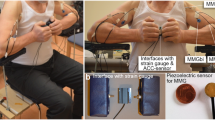Abstract
Parkinson’s disease (PD) is a progressive neurodegenerative disorder, the main symptoms of which are hypertonicity and difficulties emerging during performance of stepping movements due to increased muscle stiffness. Biomechanical (stiffness) and electrophysiological (shortening reaction, SR) characteristics of hip and shank muscles were examined in 25 patients with mild and moderate stages of PD (1 to 3 of Hoehn and Yahr Rating Scale, 61 ± 9 years) and 22 age-matched healthy controls in unloading leg conditions during passive flexion/extension of hip, knee, and ankle joints, as well as the changes in the tonic state of muscles under the influence of levodopa. The data obtained were compared with similar findings in healthy subjects. Essentially greater stiffness in all leg muscle groups (except foot extensors) was observed in patients with PD as compared to the healthy subjects. In patients with PD, SR values in hip and shank extensors as well as in foot flexors and extensors were essentially greater then in the healthy subjects. The medicine essentially reduced the stiffness of hip flexors and knee flexors and extensors. The SR persisted, although the frequency of its occurrence decreased in half of studied muscles, and a significant decrease in the SR value was observed in foot extensors. The medicine had no marked effect on the SR in the proximal muscles. Thus, the increased muscle stiffness in patients with PD manifests itself as distorted reactions to external disturbances and increased reflectory reactions of muscles.
Similar content being viewed by others
References
Fung, V.S. and Thompson, P.D., Rigidity and spasticity, in Parkinson’s Disease and Movement Disorders, 4th ed., Jancovic, J.J. and Tolosa, E., Eds., Philadelphia: Lippincott Williams and Wilkins, 2002, p. 473.
Rondot, P. and Metral, S., Analisys of the shortening reaction in man, in New Developments in Electromyography and Clinical Neurophysiology, Desmedt, J.E., Ed., 1973, vol. 3, p. 629.
Andrews, C.J., Burke, D., and Lance, J.W., The response to muscle stretch and shortening reaction in Parkinsonian rigidity, Brain, 1972, vol. 95, no. 4, p. 795.
Westphal, C., Uber eine Art paradoxer Muskel-Contraction, Arch. Psychiat. Nerven, 1880, vol. 10, p. 243.
Andrews, C.J., Neilson, P.D., and Lance, J.W., Comparison of stretch reflexes and shortening reactions in activated normal subjects with those in Parkinson’s disease, J. Neurol. Neurosurg. Psychiatry, 1973, vol. 36, p. 329.
Walsh, E.G., Shortening reactions in the human forearm, J. Physiol., 1976, vol. 256, no. 1, p. 116.
Berardelli, A. and Hallett, M., Shortening reaction of human tibialis anterior, Neurology, 1984, vol. 34, no. 2, p. 242.
Angel, R.W., Shortening reaction in normal and parkinsonian subjects, Neurology, 1982, vol. 32, no. 3, p. 246.
Xia, R. and Rymer, W.Z., The role of shortening reaction in mediating rigidity in Parkinson’s disease, Exp. Brain Res., 2004, vol. 156, no. 4, p. 524.
Xia, R., Sun, J., and Threlkeld, A.J., Analysis of interactive effect of stretch reflex and shortening reaction on rigidity in Parkinson’s disease, Clin. Neurophysiol., 2009, vol. 120, no. 7, p. 1400.
Angel, R.W. and Lewitt, P.A., Unloading and shortening reactions in Parkinson’s disease, J. Neurol. Neurosurg. Psychiatry, 1978, vol. 41, p. 919.
Kuno, S., Parkinsonian tremor, rigidity and flapping tremor, Nippon Rinsho, 1993, vol. 51, no. 11, p. 2823.
Giladi, N., Gait disturbances in advanced stages of Parkinson’s disease, Adv. Neurol., 2001, vol. 86, p. 273.
Crenna, P., Carpinella, I., Lopiano, L., et al., Influence of basal ganglia on upper limb locomotor synergies. Evidence from deep brain stimulation and L-DOPA treatment in Parkinson’s disease, Brain, 2008, vol. 131, p. 3410.
Selionov, V.A., Ivanenko, Y.P., Solopova, I.A., and Gurfinkel, V.S., Tonic central and sensory stimuli facilitate involuntary air-stepping in humans, J. Neurophysiol., 2009, vol. 101, no. 6, p. 2847.
Hoehn, M.M. and Yahr, M.D., Parkinsonism: onset, progression and mortality, Neurology, 1967, vol. 7, no. 5, p. 427.
Zhang, T., Wei, G., Yan, Z., et al., Quantitative assessment of Parkinson’s disease deficits, Chin. Med. J., 1999, vol. 112, no. 9, p. 812.
Lee, R.G., Pathophysiology of rigidity and akinesia in Parkinson’s disease, Eur. Neurol., 1989, vol. 29,suppl. 1, p. 13.
Dietz, V., Reflex behavior and programming in Parkinson’s disease, Adv. Neurol., 1993, vol. 60, p. 375.
Moore, A.P., Impaired sensorimotor integration in parkinsonism and dyskinesias: a role of corollary discharges?, J. Neurol. Neurosurg. Psychiatry, 1987, vol. 50, p. 544.
Rickards, C. and Cody, F.W., Proprioceptive control of wrist movements in Parkinson’s disease. Reduced muscle vibration-induced errors, Brain, 1997, vol. 120, p. 977.
Khulados, E., Cody, F.W., and O’Boyle, D.J., Proprioceptive regulation of voluntary ankle movements, demonstrated using muscle vibration, is impaired by Parkinson’s disease, J. Neurol. Neurosurg. Psychiatry, 1999, vol. 67, p. 504.
Dietz, V. and Duysens, J., Significance of load receptor input during locomotion: a review, Gait Posture, 2000, vol. 11, no. 2, p. 102.
Duysens, J., Van Wezel, B.M., and Smits-Engelsman, B., Modulation of cutaneous reflexes from the foot during gait in Parkinson’s disease, J. Neurophysiol., 2010, vol. 104, no. 1, p. 230.
Wright, W.G., Gurfinkel, V.S., Nutt, J., et al., Axial hypertonicity in Parkinson’s disease: direct measurements of trunk and hip torque, Exp. Neurol., 2007, vol. 208, no. 1, p. 38.
Raudino, F. and Leva, S., Involvement of the spinal cord in Parkinson’s disease, Int. J. Neurosci., 2012, vol. 122, no. 1, p. 1.
Author information
Authors and Affiliations
Additional information
Original Russian Text © I.A. Solopova, V.A. Selionov, D.S. Zhvansky, Yu.P. Ivanenko, L.A. Chernikova, 2014, published in Fiziologiya Cheloveka, 2014, Vol. 40, No. 2, pp. 14–21.
Rights and permissions
About this article
Cite this article
Solopova, I.A., Selionov, V.A., Zhvansky, D.S. et al. Investigation of muscle tone in patients with Parkinson’s disease in unloading conditions. Hum Physiol 40, 125–131 (2014). https://doi.org/10.1134/S0362119714020157
Received:
Published:
Issue Date:
DOI: https://doi.org/10.1134/S0362119714020157




